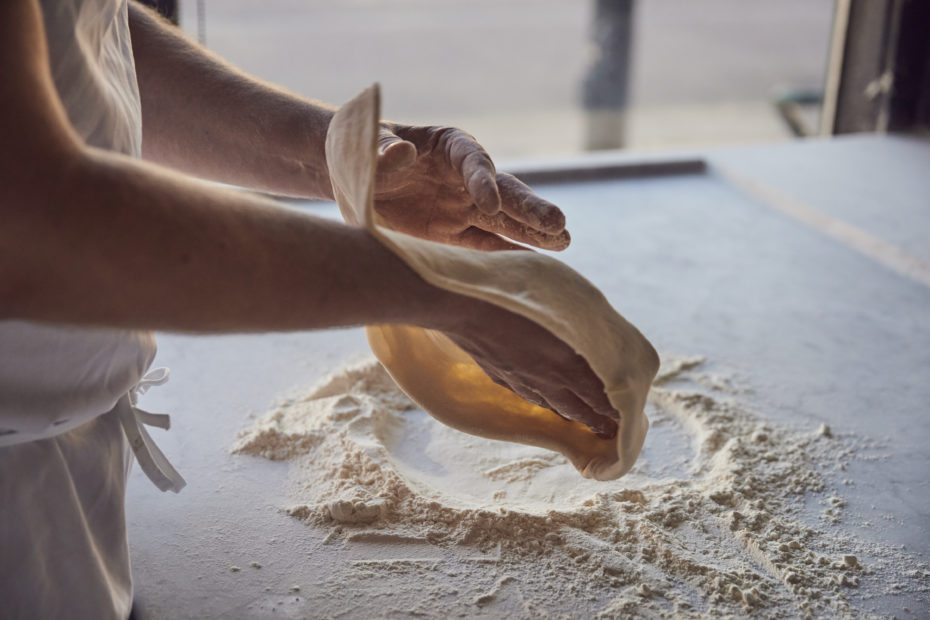Many people debate the “correct” way to make a pizza crust. There’s the iconic image of the pizza-maker swirling the crust over his head; but there are also cooks who swear that rolling the crust out is the only way to go.
There really shouldn’t be a debate, though, because whether a crust is hand-stretched or rolled out depends completely on the kind of pizza one is trying to achieve.
Here at Pizzeria Locale, we define our pizza style as “Neighborhood Neapolitan.” This style has four cornerstones:
- four ingredient dough
- fermented overnight
- stretched by hand
- baked in our super-hot Neapolitan smart oven
All of these four cornerstones work together to make our pizza delicious, and missing out on any of them would be unthinkable. In previous articles we’ve explored what makes a Neapolitan pizza, why the hot oven matters, why we use only four ingredients in the crust, and what the fermentation process does… so it makes sense now to tackle the question, why does it have to be hand-stretched?
It’s a good question. It’s for sure not the easiest way to make a pizza crust. We have to invest significant time training all our crew to stretch pizza by hand. And most other fast-casual pizzerias use a rolling pin or a pizza dough press. Why don’t we?
The real answer is that stretching pizza by hand makes a significant difference in the pizza’s crust, and that’s worth every bit of investment. It’s a skill each pizza maker learns over time, and the best pizza makers in the world take years to perfect their craft. And yes, it’s all worth it!
Straight out of Naples
Pizza originated in Naples, Italy, and the Neapolitan style of pizza remains perhaps the purest of all pizzas. You’ve probably noticed that Neapolitan pizzas have an iconic round(ish) shape, which is something you can only create through hand-stretching the dough. The best way to achieve the perfect Neapolitan stretch is by moving most of the air from the center of the dough to the edges. This stretching method creates a hand-tossed, medium-thickness crust pizza, which can then be topped with anything.
Neapolitan pizza is characterized by a thin base with puffy crusts and patches of charring from the flames.
But what’s the difference?
The fundamental difference between rolling and stretching dough is in the pizza’s uniformity, crust hole structure, and size. At Pizzeria Locale, when we mix the dough, the yeast feeds on the flour and starts fermenting, creating CO2 gas that builds up pockets and allows the dough to rise.
When the dough is stretched, larger holes are created in the crust.
How do we do it?
- We press the dough ball into a disk with our fingertips, working from the center out, pushing the pockets of gas outward.
- Once the base is flattened, we use both hands to stretch the dough apart, turning as we go along.
This stretching technique allows the pizza to retain some of the gas bubbles in the dough at random places, so that as it cooks, the bubbles will rise and the resulting crust is large, irregular, and takes on a style often called “artisan.”
Rolling a pizza, on the other hand, offers a mostly uniform but denser crust, with smaller holes. Rolling pizza dough pushes the pockets of gas out of the dough, creating a thinner, denser crust.
What about tossing the pizza?
Tossing the dough isn’t a necessary step with our Neighborhood Neapolitan style of pizza. It’s a better technique for New York Style pizza which is made with a high gluten dough. The firmer dough used in NYC style pizza can hold up to the tossing and it’s an easy way to stretch a big pizza.
It looks good, but if you’re making pizza at home you will do just fine stretching by hand on a counter—and avoid the mishaps inherent in throwing food around your kitchen!



